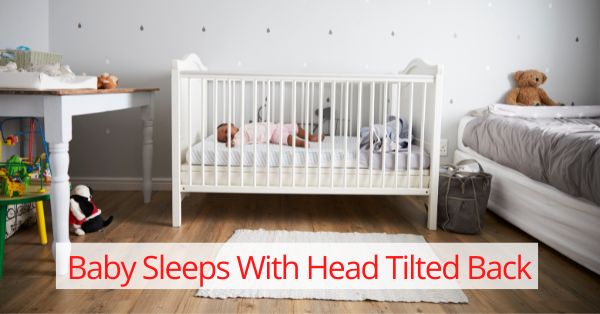There is nothing worse than waking up to find you have slept in an awkward position so when you see your beautiful baby sleeping you may feel concerned over the angles they choose when sleeping, not wanting them to feel the pain of a pulled neck. If your baby sleeps with head tilted back, is there any need to worry?
Baby Sleeps With Head Tilted Back – Why?

The main reason a baby sleeps on side with head tilted back is known to be called Torticollis. If your baby was cramped in the womb it can cause a one-sided strain in the muscles in the neck. The tighter the muscle is pulled the more noticeable the tilt. It may just reflect what they were like in the womb.
Baby and Sleep
Your baby is your entire world. You grew them and nurtured their little beings so when they enter the world it’s not unusual for you to stare and wonder about them as they sleep soundly.
Being a parent is a mix of love, proud moments, and of course worry! No one prepares you for the emotional rollercoaster you have just jumped on.
Sleeping was always a big anxious part of my early parenting days. There is always so much pressure on us as sleep deprived moms to ensure the safety of our bundles while we recharge. I always hoped that my intuition would wake me if they ran into difficulty but there is always that hint of fear still lurking.
With SIDs being at the forefront of every parent’s worst nightmare there is no wonder you are starting to notice how your baby behaves whilst sleeping. As you watch your baby’s chest rise and fall with every breath you begin to think, is it normal for baby to sleep with its head tilted back? How do I keep them on their back?
What is Torticollis?
According to Kids Health Torticollis otherwise known as Congenital Muscular Torticollis can appear if your baby was cramped in the womb, if you had a multiple birth, or an assisted delivery.
Each of these can increase the pressure on the neck muscle known as the sternocleidomastoid muscle. This is the band of muscle that runs from the head down the neck and to the collar bone. Being in one position for a long time can tighten this band and make it harder for your baby to turn. They may also favor that side as they grow, meaning you may not notice the signs of this condition straight away.
So, why does my baby sleep with head tilted back? A simple muscular habit that has caused a muscular spasm!
You look at your baby and see this perfect little human yet that head tilt is giving you a bit of angst. The good news is that your baby won’t be in pain from it. It doesn’t feel like he/she has a twisted neck, we all know how painful that is! In fact they probably feel comfortable in this position, we all have that comfy way we drift off after all.
Needless to stay, even though this condition causes no major concern there are things you can do to help loosen this overly tightened muscle.
Signs and Symptoms
If your baby likes to sleep with head tilted back, as we have discovered, they shouldn’t be in any pain. But it is important to look out for the important signs and symptoms as according to pediatrician David Burke “Torticollis can be frightening for parents. But most kids do very well, especially when torticollis is identified early and treated quickly.”
- The most common symptoms to look out for in your baby are:
- Sleeping with their head tilted in a preferred direction.
- Difficulty turning their head in the opposing direction.
- Plagiocephaly, this is known as flat head syndrome where the skull forms flatter on one side.
- Premature babies are also more prone to developing Torticollis as they may be hooked up to lines leaving them in one position for longer periods.
If you notice any signs like the ones above then there are treatment options to ensure your baby can learn to use both sides of their neck muscles.
Diagnosis and Treatments of Baby Sleeping With Head Tilted Back
If your baby sleeps with head tilted back they can undergo simple stretching techniques to regain strength in their neck. To determine if your baby has Torticollis your doctor will monitor and measure how far they can turn their neck and may ask you to observe the range of their neck movements.
How Can You Help?

When my daughter went to visit our Doctor in a general check up she noticed that my daughter preferred turning her head to one side. She then insisted on measuring her neck strength by checking her ability to move to the opposite side. As my daughter didn’t show any reluctance turning it was thought there wasn’t any cause for concern but I was encouraged to include neck movements during our playtime to prevent Torticollis from developing.
If you do have this diagnosis then here are some simple and engaging ways to help regain strength in the weekend muscle.
- Feeding – we are all guilty of favoring an arm to give a bottle or repeating a favored position to breastfeed. Offering your baby their milk from the opposite direction can help entice them to turn.
- Sleeping – you always have to put your baby to sleep on their back to help prevent Sudden Infant Death Syndrome (SIDS) placing your baby down with them facing the opposing side can help stretch the neck but don’t be alarmed if they regain their usual sleeping position, providing they remain on their back they will always turn to their comfiest position.
- Tummy time – playing and engaging with toys is a great way of getting your baby to follow through with good neck movements. Whilst on their tummies you could move it slowly from side to side to encourage them to follow. If your child is not showing interest in toys just yet, use your face and voice coach them in a soothing manner after all they love you and your voice so will be more likely to follow you.
The important thing to remember here is that your baby cannot hurt themselves when they are moving their own head. They will stretch as far as they can before feeling uncomfortable so short bursts of these exercises will be enough. You should never use your hand to try and stretch their neck or turn their heads. This won’t only distress them but you cannot gauge how far they can go and overstretching their muscles can hurt them.
Can Head Tilted Back Sleep Appear in Older Children?
You may have noticed that simple infections like tonsillitis or swollen lymph nodes can cause stiffness in the neck of older children. As well as sleeping in an awkward position which sends the neck muscles into spasm.
If you find your older children are struggling then a trip to the doctor for antibiotics can rectify any infection. Usually an older child will regain neck control after a few days.

When to Seek Help
If you notice any of the symptoms mentioned above then seek advice from a doctor to ensure you are on the best course of treatment. Typically stretching exercises work best between ages of three months to six when your baby is gaining control over their head movements.
It is best to get a diagnosis earlier rather than later to ensure the best possible outcome with stretching treatment.
In the result you feel your baby isn’t getting stronger then they may need a referral to a physiotherapist or take the surgical route.
‣ Physical Therapy
If you have followed the at home stretch techniques and are still concerned then your doctor can recommend a few physical therapy sessions. This is where a trained professional can help motivate the lazy muscle through more intense stretches. Every few weeks the doctor will monitor progress by measuring the degree of angle of your baby’s head turning.
‣ Surgical Treatment
Surgery is thankfully only in extremely rare cases. The muscle in question will be cut and lengthened so the tension can be released. It is thought that this is the last case of treatment affecting only 10% of children.
Wrapping Up
To conclude, having a baby sleep with head tilted back isn’t anything to usually worry about.
As we have discussed the cramped surroundings can lead to your baby preferring laying on one side or tilting their head as they sleep. I suppose you could call it a form of habit that can develop into Torticollis in the first instance.
If you notice anything like reluctance of moving their head to the opposite side, or notice a sign of flat head syndrome then if you haven’t already sought advice from a professional then it is recommended you do so as soon as you can. This way you can start stretches that help strengthen the weakened muscle.
More to read: